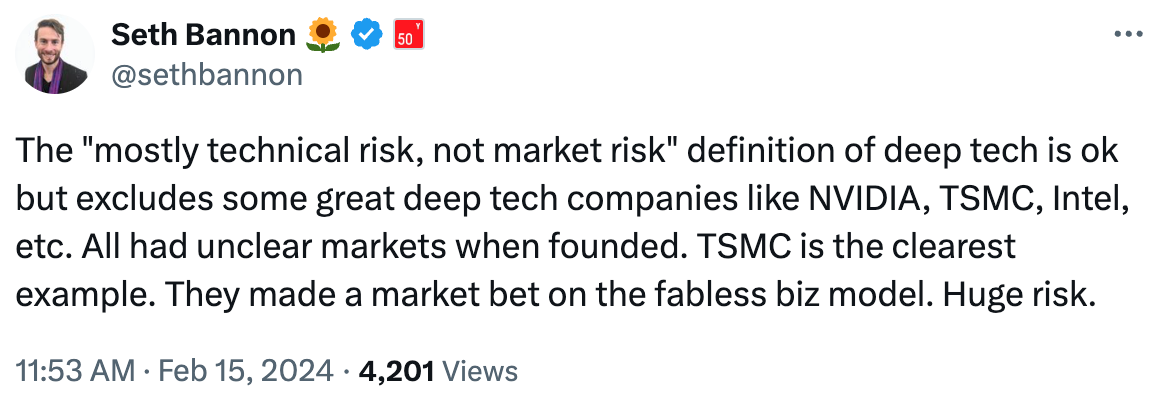Deep Tech Startups: Technical vs. Market Risk
Breaking down "deep tech" with another 2x2.
What is “deep tech”? My definition:
A deep tech startup builds and scales technology at the frontier of what’s possible using applied research or novel combinations of existing tech.
Deep tech has been defined by others as a startup having primarily technical risk, but no market risk, of the “if you build it, they will come” variety.
Seth Bannon pushed back on this a few months ago:
I agreed, and after thinking about it more, I feel that both these are their own dimensions:
The dimensions here are:
↕ Technical risk — aka “novelty uncertainty”. High tech risk = “deep tech” at the frontier of practical technical applications (really hard to build). Low tech risk = well-known and understood tech.
↔️ Market risk — aka “complexity uncertainty”. High market risk = market is new/unknown. Low market risk = demand and needs are clear.
These scales may not be true “risk” as in the risk of loss, but more like uncertainty as Jerry Neumann describes in this really good essay, calling them instead novelty uncertainty and complexity uncertainty.
The quadrants:
“Field of Dreams” (↑ tech, ↓ market): Distribution is straightforward if product works. SpaceX Falcon 1, fusion, fission energy 1960-1980, AGI, Genentech, mRNA vaccines.
“Frontiers” (↑ tech, ↑ market): Hard to build, market is a hypothesis. Building new frontiers. NVIDIA, TSMC, SpaceX Falcon 9, Tesla, small modular reactors, ChatGPT.
“Pioneers” (↓ tech, ↑ market): Easy to build v1 but distribution is hard; initially product is only differentiated on brand + design. Exploiting new frontiers. Social media, Uber, Airbnb, Groupon, most consumer SaaS.
“Arbitrage” (↓ tech, ↓ market): Closing arbitrages or expansion of proven ideas. Instagram cloning Snap features, “DoorDash for India”, many vertical SaaS products, Rocket Internet / Samwer brothers.
In general, Frontiers yield the best investment returns. It pays to resolve a lot of technical and economic uncertainty. There are other dimensions of course and you can be successful (or not) in any of these quadrants. Some Arbitrages can be huge. And some Frontier products can be commoditized.
Field of Dreams seems like the place to be: “if you build it, they will come.” The tech may not pan out though — and even if it does, if the breakthrough is easily copied it can be competitive. There has to be something that makes it hard to copy.
The median VC-backed startup is in the Pioneer quadrant. The tech is straightforward to implement. The market is new and uncertain for whatever reason, but more than likely it’s because of a frontier that was recently opened up by another technology. This makes distribution really hard. Either there’s no one there and demand has to be created, or the demand is obvious and there’s a ton of competition until the uncertainty is resolved (and winners have scaled).
Frontiers open up new markets for pioneers to fill. Like microprocessors leading to business software or smartphones leading to Uber.
Arbitrage are “sure things” more akin to exploiting a market inefficiency. There’s demand the market isn’t supplying and it’s pretty clear how to close the gap. Parts of the business world can be surprisingly inefficient.
* * *
What about other dimensions? I can think of a handful of others that would be good to categorize startups. For example, R&D cost vs. scaling cost (potentially distinguishing “deep tech” and “hard tech” startups).
But I’ll leave those for another post.
Thanks to Celeste and Eric Jorgenson for feedback.





